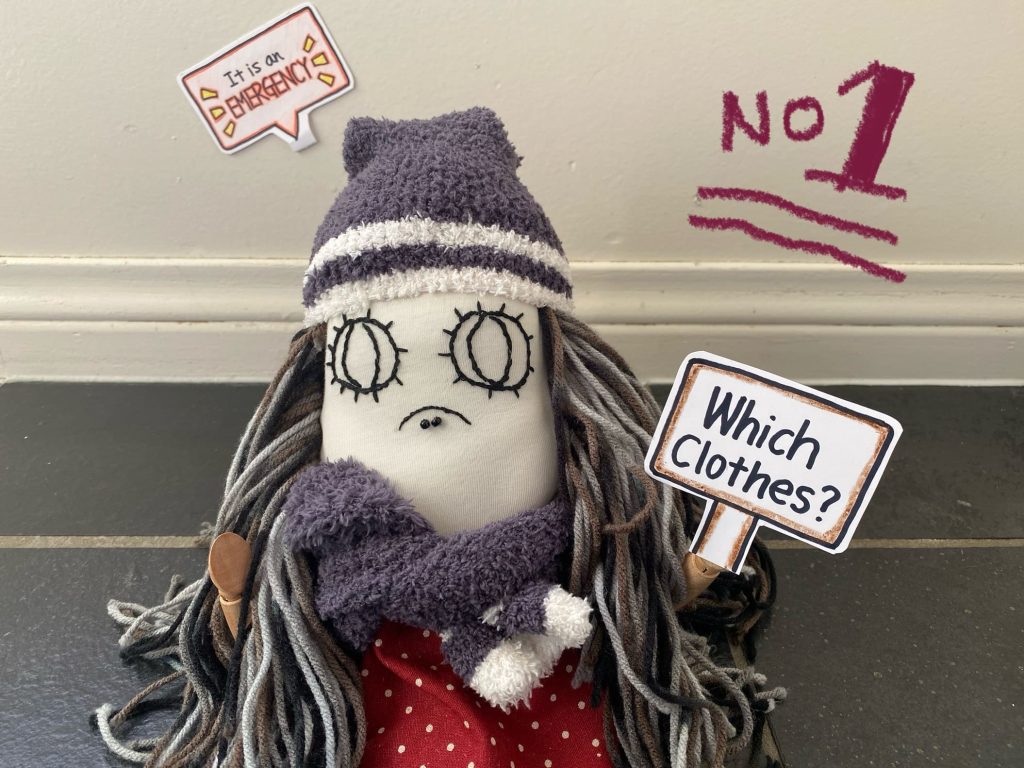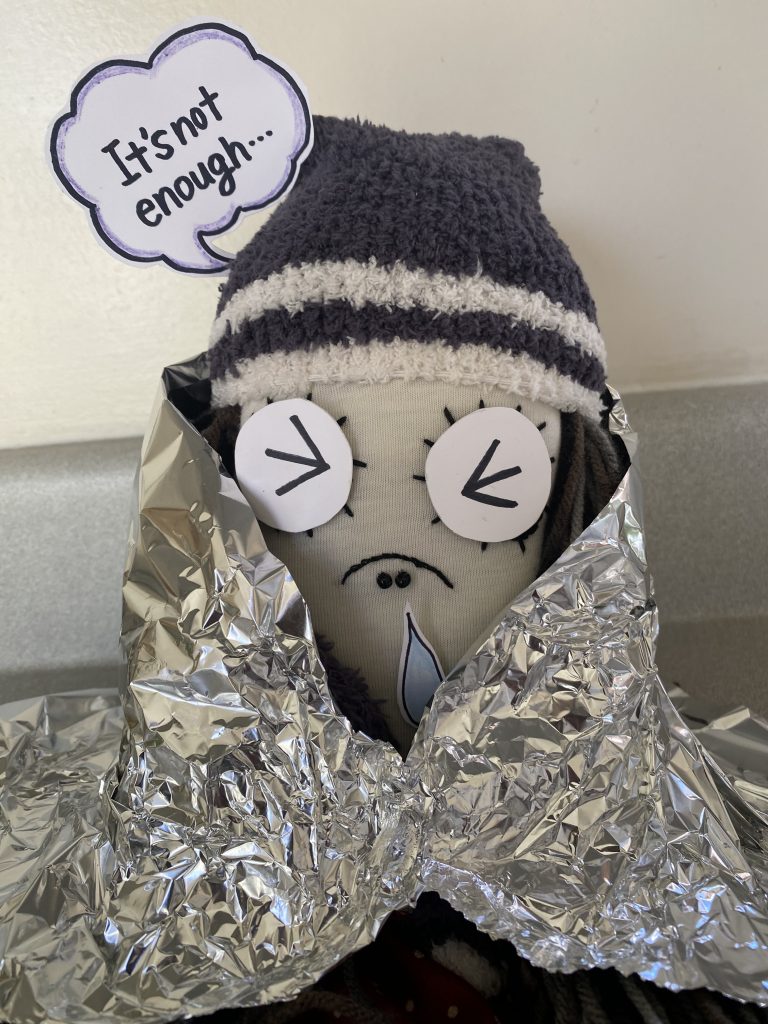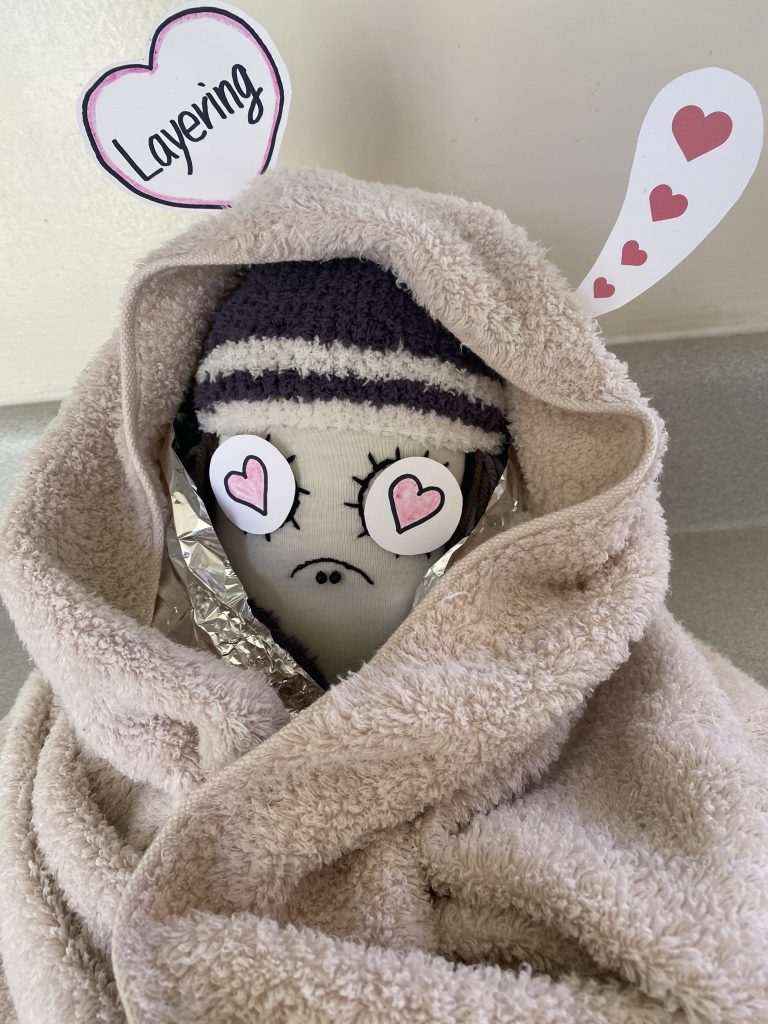
Before I buy emergency winter clothes, what do I need to know?
I just wear layers, right?
My area has a warm climate, all year round.
I don’t have any winter clothes. What should I get?
How about summertime?
Let’s imagine you have to stay inside a refrigerator for 2 days. To get a feel for it, open up your refrigerator and stand in front of it for 2 minutes. What do you think?
You need warm clothes, right?
People who live in cold climates know the proper techniques for wearing winter clothes. On the other hand, my area is not so cold, and I see some people wearing flip-flops, even in December, while I am wearing extra socks and a scarf. Each person has a different body and different tolerances. And each person has their own tendencies toward warmer or cooler clothes. After a major disaster, in order to be prepared, we need at least a basic knowledge of cold-weather gear.

Many web sites recommend getting emergency thermal blankets for emergencies. Some people follow this advice and seem to be satisfied.
But wait a minute! In reality, the thermal blanket is not enough, and there are some pitfalls. I recommend emergency blankets, too, but if you know the basics of protecting yourself against the cold, you will be able to use your cold-weather gear much more effectively.
First, we need to know the simple mechanisms of insulation, layering and ventilation in clothing.
Then you should check your own clothes and buy new clothes if needed.
Insulation, layering and ventilation in clothing
Clothing provides insulation and helps retain body heat. When you wear multiple pieces of clothing, one on top of the other (layering), each layer creates an insulating pocket of air that protects you better than just wearing a big, thick jacket. Also, layering helps move sweat and moisture away from your skin. In cold weather conditions, layering traps air and creates a barrier between your body and the environment. (For more info, check out: insulation clothing.)
Some materials are better insulators than others, and some provide better ventilation and breathability to help with sweat evaporation. It can get pretty complicated when you consider all the options.
A simple way to think about it is: add another layer if you get cold, and take off a layer when you get hot or wet.
The mechanism of heat loss from the body
• Heat radiates from unprotected surfaces of the body.
• Direct contact with something very cold (cold water, cold ground, wet clothes, etc.) draws heat away from the body.
• Wind carries away the thin layer of warm air at the surface of the skin. Wind chill factor is important when considering heat loss.
• Evaporation has a cooling effect. When water or sweat evaporates, the temperature at that spot goes down.
What is the acronym COLD ? Keep it in mind
• Keep it ⇢ Clean: Clean clothes are better insulators and are more water-resistant than dirty clothes. (Pay special attention to your socks. Clean, dry socks help keep your body warm.)
• Avoid ⇢ Overheating: If you sweat , you are going to be wet, and if you are wet you are going to be cold. (The body cools when sweat evaporates.) The combination of wet clothing and cold weather can cause the body to lose heat very quickly.
• Wear it ⇢ Loose in layers: Several loose layers provide more insulation than one thick layer, because the layers are able to trap air in between. Loose clothing allows for good blood circulation, which helps to keep your extremities (fingers and toes) warm.
• Keep it ⇢ Dry: Keeping dry is critical to staying warm. Get out of wet clothing as soon as possible.
The function of each layer
• Base layer: is closest to your skin. It is important for the fabric to wick sweat away from your skin. Polyester and nylon are good for this, or natural fibers like merino wool and silk. (For more info, check out Outdoors Father).
• Middle layer: retains body heat to protect you from the cold. Some people choose to wear more than one middle layer. (Fleece under a shell, mountain jackets, down-insulated jackets, synthetic insulated jackets, etc.)
• Outer layer: shields you from wind and rain. Waterproof/breathable jackets, water-resistant/breathable jackets, or down jackets, etc.
Start with a base layer, then add middle layers, and then an outer layer.
Tips for Dressing

★ Remember, the human body generates heat. We are “homeothermic” animals!
There’s no reason not to take an advantage of that. So you might think it would be a good idea to be active in the cold and even exercise, in order to keep yourself warm. Right?
No, no, no!! Reuse that heat with layering to keep your body warm, but avoid strenuous physical activity that makes you sweat. Vigorous activity and exercise lead to sweating, wet clothing and heat loss. Also, we consume lots of valuable energy when we exercise. Inadequate nutrition and fatigue can result in low blood sugar, and low blood sugar can reduce your body’s ability to shiver (shivering is a natural reaction that helps you stay warm). Low blood sugar can also reduce the body’s ability to generate its own heat. Remove or loosen clothing as needed to prevent sweating, and do not forget to eat snacks to keep your energy up.
★ Tight-fitting clothing reduces insulation, restricts movement and leads to heat loss.
★ Cover your neck and head to keep warm.
Your neck and your head both have a high concentration of blood vessels, close to the skin’s surface, making them susceptible to heat loss. Wrap a scarf around your neck and wear a hat.
★ Wear a ski mask or a scarf to cover up around your nose and mouth.
Doing this can trap some of the heat and moisture from your breath. When breathing in cold air, your body loses heat as it warms the air to its own, internal temperature. Cold air is dry, and your body needs to work hard to stay humidified and to retain moisture. Breathing extremely cold air can result in a condition called bronchospasm. Bronchospasm is characterized by a narrowing and tightening of the airways; symptoms include irritation to your airways and shortness of breath. Be especially careful if you or your loved ones have chronic or pre-existing respiratory conditions.
★ Do not forget to cover your wrists and ankles well.
The blood vessels and nerves in those spots are close to the skin, and there is typically not a lot of fat there to insulate the underlying tissues. Your body can easily lose heat from your ankles and wrists. Wear gloves or mittens and long socks.
★ Avoid cotton. Cotton absorbs moisture, so it stays wet longer.
★ Prepare extra socks. Socks must be changed whenever they become wet (e.g., from rain, snow or sweat). This may require changing into dry socks several times, daily.
★ Drink water, even in cold weather.
Wearing too much clothing can cause overheating, especially when engaging in physical activity. Overheating, in turn, leads to sweating (this is part of the body’s natural ability to balance heat production and heat loss). Cold can decrease your awareness of just how thirsty you are. This potential loss of sensitivity to thirst increases the risk of dehydration.
When you prepare warm clothes for emergencies, this basic knowledge will help you. If you live in an area with a warm climate, you should not underestimate rain and wind. Weather can be weird and unpredictable, and recently (seemingly) even more so. Even the minimum cold-weather gear is OK. I don’t have severe winter clothes, but I try to have substitute items handy, instead of really good ones. Maybe I am stingy, but it’s ok!! I will talk about the substitute items and what kind of clothes I prepared for emergencies, in my next post.
See you next time.
Remember, “Protect your life by yourself” (自分の命は自分で守る). You need to survive first, and then you need your emergency supply. No matter how well you prepared your emergency supplies, if you die, then all of your preparations will have been for nothing. First and foremost, keep your health up all the time. Build your stamina so that if you need to, you can evacuate as quickly as possible. Stay healthy.
More Goriyama Posts
Pingback: Which Clothes Are Good for Staying Warm in an Emergency? (2) #60 – Goriyama